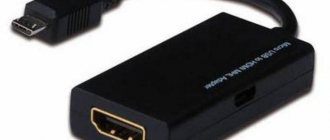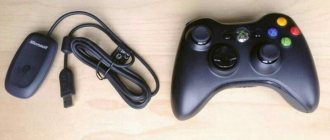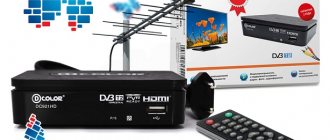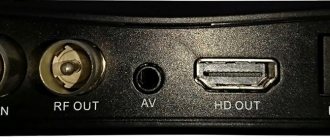Problems with signal distribution to TVs
About 10-15 years ago, modulators, then still analog, were used mainly in two cases: to watch the same program from a satellite receiver on several TVs and to connect video eyes and video cameras to TVs.
At the same time, users are accustomed to having one camera configured in one program and another in another. You could switch between them using the remote control, and the image was visible on all TVs - convenient. Nowadays, large-diagonal TVs have become more affordable, and cameras have learned to broadcast high-definition images - as a result, the image on the screen has good detail.
But connecting to a TV has not been simplified. CCTV cameras can be of two types: analogue HD and IP-enabled. Neither one nor the other can be connected directly to the TV. The cameras are connected either to an AHD-HDMI converter or to a DVR. In any case, the output of such a device must be an HDMI connector that connects to the TV. This is where problems arise. You can use an HDMI splitter to distribute the signal to several TVs. But it has limitations on the number of outputs, distance (usually tens of meters), and it is necessary to lay additional cables. In addition, many users find it inconvenient to have to switch to HDMI input mode to view a broadcast from the camera.
Connecting to Smart TV
This option is the most preferable because it is the simplest. As you know, TVs with Smart TVs are quite common, so they can no longer be called market novelties. Connecting a CCTV camera to such a TV has the following advantages:
- Thanks to Smart technology, it is possible to access the Internet directly from the TV;
- To make entering information and working on the network easier, you can use additional accessories, for example, mice and keyboards for TVs;
- a wide screen that allows you to view the image from the IP camera in detail, even while in another room.
To connect an IP camera to a Smart TV, you need to follow several steps. On the video surveillance service, you need to register an account, and then use a unique numbering to add all the camera’s IP addresses there. In this case, it is possible to group devices according to their true location or the subject of information transmission. As a rule, the service interface is not complicated, so you can easily select and enable image transmission from one camera in the list.
Next, the TV is configured to access the Internet using the data provided by the provider. Once you have succeeded in logging into the network, you need to enter the address of the video surveillance service in the search, enter your personal account and select the required device to view.
Choosing a modulator type
To be able to view according to the old principle - when the image from the camera is visible on a certain channel - it is necessary to use a digital modulator. How to choose the right type of modulator? Commercially available modulators are of the following types: supporting the DVB-T standard, DVB-C standard and combined (DVB-T + DVB-C). DVB-T modulators generate a signal of an outdated broadcasting standard. However, this does not prevent this signal from being used in the cable. This signal will be received by all modern TVs. The same can be said about DVB-C modulators. Universal modulators can generate a signal from both standards. When choosing a modulator standard for generating your television signal, it is advisable to choose the same standard (ether or cable) in which television programs are received. This makes it possible to select your channel in the same way as choosing a TV program, and see it in the list of programs. With different modulator and television broadcasting standards, more steps are required to select the reception mode (cable or antenna), which poses difficulties for the average user.
RF modulator, or watching a “satellite” in the kitchen.
Inexpensive RF modulator/converter. I’ve been watching satellite TV for more than 10 years, and what’s especially enjoyable is the combination of pleasant viewing mixed with the abuse of morning/evening coffee/tea/beer (underline as appropriate) right at the kitchen table, so as not to distract the peacefully sleeping household members in the morning/night. And when you are in charge of the kitchen, sometimes you want to observe events not only out of the corner of your ear, but also with your eye. How it works:
Background:
In the pre-HD era, most VCRs/set-top boxes/receivers had a so-called “antenna” output, and if your TV did not have a SCART/AV (in common parlance “tulips”) input, then you could connect an audio-video signal source through that same “antenna” (RF out) output by tuning the TV receiver to the desired channel. In those distant days, I had a HUMAX 5400z, and during the renovation, the coaxial cable was laid behind the baseboard, as was the antenna socket for the TV in the kitchen. But time passed, hardware changed, technology did not stand still. All sorts of IPTV, HDMI appeared, Internet was installed at home, SAT providers switched to MPEG4, which my old 5400z no longer reached speeds above 44,000 baud, and the old AIWA 14″ continued to serve faithfully, hanging idle at a height of 1.9 meters under the ceiling in the kitchen. After all, I have an IPBOX910 with Linux on board, Ethernet, Screw and Aunt Shura, but without (as in most modern DVB-S2 receivers) an “antenna” output. There was a toad pressure to buy an AV transmitter on a radio channel, because... I have the cable laid, the socket is installed, I was considering the option of purchasing “AV to UTP”, but I don’t want to break the tie and rip off the tiles on the floor. Actually, what am I talking about all this... Oh, yes, to the author of the review. I’ve been trying to find something for a long time, there was something on eBay, but recently they started posting inexpensive copies for sale on Ali.
I won’t burden my readers’ eyes with useless parcel tracking, because... Delivery times to CIS countries defy any logical explanation. Sent by ChinaPost, arrived in 25 days, of which 2 weeks by “blue-eyed” route. The packaging is “so-so”, without a bubble, the retail box is wrapped in yellow tape, and a piece of paper with the address is pasted on top. It was nice that the “sold” one dropped a photo of the parcel with the track before sending it.
It's simple, IPBOX 910 can simultaneously output a picture to the HDMI output in 1080i format and downscale it to 576p on SCART.
The “Chinese” has three sockets for connecting an audio/video signal, an RF output and an antenna input (so that you can also watch the over-the-air signal). It probably also works as an antenna amplifier, although I could be wrong - I haven’t tested it.
The power cord is for a Chinese outlet. I prepared for the latter in advance and, in order not to breed a herd of adapters, prepared a donor O
rgan.
We connect, watch, rejoice. Don't Drink'N'Drive, Better Smoke'N'Fly!
Connection via RCA
If there is no advanced modification of the TV, you can use a device that has an RCA signal connection interface. You can also connect a CCTV camera to such a device.
Most IP cameras transmit signal using a BNC connector. Accordingly, it is necessary to ensure a transition from one signal to another. To do this, you will need to purchase two connectors: a regular tulip-shaped connector and a male connector for the BNC. They can be connected using a coaxial cable with a resistance of 75 ohms. After connecting the adapter on both sides to the video camera and TV, you can configure the input signal. This is usually done in AV or Composite mode.
Video modulator
In order for the intercom video camera signal to be sent to the home television network, it must be transferred to the television frequency range 50-1030 MHz. This is the frequency spectrum on which television channels 1-90 are broadcast.
For this purpose, special devices are used - video signal modulators . The modulator is installed in the gap of the high-frequency cable connected to the antenna input of the TV.
The intercom video camera is connected to the modulator, the modulator converts its video signal and mixes it into the cable television network.
The signal from the video camera is tuned on the modulator to a specific frequency corresponding to a specific television channel. By turning on this channel on the TV using the remote control, you can view the image from the video camera on its screen. Moreover, the image can be viewed on any TV connected to the home television network.
If desired, using a modulator, you can also output sound from the intercom calling panel or from an external microphone.
What is an external RF modulator and how to connect it?
The RF modulator, which is presented by modern manufacturing companies, is a device powered by a 220 V network and having video and audio inputs and one output. The simplest models have a connector for the antenna cable and tulip-type inputs.
A special feature of this device is that it is possible to connect dividers to it, which will distribute the signal to the required number of TVs, and the audio signal will be transmitted in mono or stereo standard.
To connect an RF modulator, you need to connect the TV receiver input and the RF OUT connector using an antenna cable. Then connect the A/V signal source to the AV IN input of the external high-frequency modulator, turn on the device and set up the TV. By installing an external device of this type, the user will be able to view all the channels offered by TELEKARTA - satellite TV.
If you need to add a modulator signal to a network with channels, you just need to connect the cable coming from the antenna to the appropriate connector and make sure that the carrier frequencies of the two devices do not coincide.
Reasons for switching from internal modulators to external ones
Previously, all receivers had an internal modulator. However, today only an external RF modulator can be found in manufacturers' catalogs. This is due to the fact that the built-in receivers had to be certified when making the slightest changes.
In addition, the first devices could not provide high image quality. This happened because the signal was lost during transmission. And if a few years ago receivers were manufactured by companies involved in the production of televisions, game consoles, DVD players and other similar equipment, today they are produced and improved by special companies. They began to create better devices and signal transmission improved significantly. The amount of loss has been reduced through the use of filters that can block certain frequencies that carry significant noise. That is why today there are many people who want to buy a dvb t2 receiver.
Details
Instead of 1N4001 diodes, any of the series 1 N4002 - 1 N4007, UF4001 - UF4007, 1N4933GP - 1 N4937GP, KD2086 KD243, KD247 are suitable. LED L-1464YD yellow, lens diameter 2 mm.
It can be replaced by any general-purpose continuous glow without built-in resistors, for example, from the L-1060, L-1464, L-934, KIPD66 series. Instead of the L78L05 integrated stabilizer, any of the ***78L05, ***78S05 series in a three-pin TO-92 package will do.
Ceramic capacitors K10-17, K10-50 or analogues. Resistor type MLT, S1-14, S1-14. Chokes L1, L2 are ready-made, small-sized, industrial-made, made on H-shaped ferrite cores; any inductance with an inductance of 10...300 μH with a winding resistance of up to 20 Ohms is suitable.
A view of the power supply and modulator source assembly is shown in the photo at the beginning of the article. When the modulator body is struck, a microphone effect is present, however, during long-term operation of the device, the frequencies of the video and audio carrier signals remain stable.
Connection diagram for intercom to TV
Considering the architecture of low-current apartments , I focused on the fact that low-current network equipment is convenient to install in a separate low-current panel . Let me remind you of the basic concept - all cables from the places where devices and equipment are installed are brought together into a low-current shield. And already inside the shield the necessary connections are made in accordance with the required configuration .
The modulator is connected to a break in the high-frequency cable coming from the video signal source (from an over-the-air antenna, cable television). The cable from the signal source is connected to the input of the modulator, and from the output with a mixed signal from the intercom video camera it is connected to the home television network. Usually this is the input of a television signal splitter, and then to the antenna inputs of televisions connected to the television network.
The signal from the intercom is connected to a special low-frequency input of the modulator. Using the setting buttons, you select the channel number on which the image from the video camera will be broadcast.
When a visitor arrives and presses the call button on the calling panel, a bell rings and an image appears on the intercom monitor. By pressing the channel number to which the modulator is configured on the TV remote control, you can view the intercom picture on the TV screen. Moreover, the image can be viewed on any TV connected to your home network.
If the visitor is not desired or the apartment is in the wrong place, you can return to watching your favorite channel.











